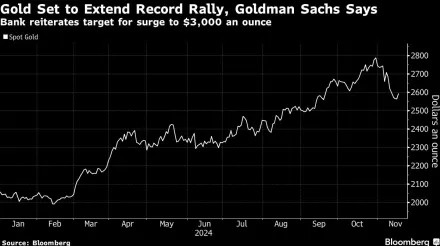(Bloomberg) -- Gold will rally to a record next year on central-bank buying and US interest rate cuts, according to Goldman Sachs Group Inc., which listed the metal among top commodity trades for 2025 and said prices could extend gains during Donald Trump’s presidency.
“Go for gold,” analysts including Daan Struyven said in a note, reiterating a target of $3,000 an ounce by December 2025. The structural driver of the forecast is higher demand from central banks, while a cyclical lift would come from flows to exchange-traded funds as the Federal Reserve cuts, they said.
Gold has staged a powerful rally this year — hitting successive records — before pulling back in the immediate aftermath of Trump’s White House win, which boosted the dollar. The commodity’s advance has been underpinned by increased official-sector buying, and the Fed’s pivot to easier policy. Goldman said a Trump administration may also aid bullion.
An unprecedented escalation of trade tensions could revive speculative positioning in gold, they said. In addition, rising concerns over US fiscal sustainability may also aid prices, they added, noting that central banks — especially those holding large US Treasury reserves — may opt to buy more of the precious metal.
Spot gold was last at about $2,589 an ounce, having peaked above $2,790 last month.
In other outlooks, Brent crude was seen trading between $70 and $85 a barrel next year, although there’s near-term upside risk if the Trump administration clamps down on flows from Iran, they said. Base metals were favored over ferrous, and European gas faced upside risks in the short term from the weather, they said.
“The new US administration further raises the risks to Iran supply,” the analysts said, citing scope for potentially tighter enforcement of sanctions in a maximum-pressure campaign. “A potential strengthening in US support to Israel may also increase the probability of disruptions to Iran’s oil assets.”
(Adds comment on oil-supply risks in final paragraph)


